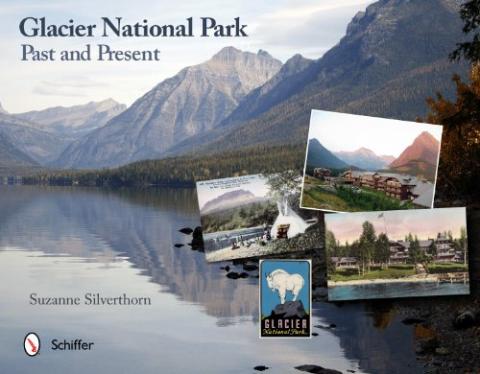Postcards -- remember them? -- have a great ability to freeze a setting in time and hold onto it for decades, if not longer. Suzanne Silverthorn capitalized on that medium, and on today's photography, to illustrate the history of Glacier National Park.
In Glacier National Park: Past and Present, Ms. Silverthorn leads us through the national park by pairing postcards -- more than a few from the early 20th century -- with more recent photographs.
Drifting through the 112 pages you can follow the role the Great Northern Railway had on the park's development, explore the grand lodges, gain an overview of Glacier's wildlife, and witness some of the changes time has handed the park.
One historical photograph Ms. Silverthorn uncovered shows a very stern-looking James Hill, the tycoon of the Great Northern Railway Co., accompanied by his son and some business colleagues during a gathering at Glacier in 1911. Also in this chapter is a postcard depicting Great Northern's Empire Builder running along the park's southern border, photos of matchbooks used to promote the railroad and Glacier, and a railroad time-table brochure promoting the fact that the Empire Builder was "air conditioned."
Flip through the pages and images of Logan Pass and the Going-to-the-Sun Road with its engineering feats pop out, and postcards showing off the exteriors and interiors of lodges (the postcard depicting the Sun Parlor" at the Glacier Park hotel in East Glacier dutifully captures most of the chairs pointing out the windows) fill pages.
Take a close look at the postcard on page 35, which shows off the fireplace in Lake McDonald Hotel. Would the Park Service today allow a bear-skin rug, complete with head and gaping mouth, to grace a hearth?
The early photographs and postcards of the Sperry and Granite Park chalets, built by the railroad to cater to guests exploring the West by rail and horse trips, show off some great views and interesting aspects that no longer are in place, such as the 12 "cribs" that once extended from the Granite Park Chalet for use as guest rooms.
Ms. Siverthorn's eye for detail also is reflected in her selection of postcards of Trick Falls (now called Running Eagle Falls) in the park's Two Medicine area. This curious waterfall is two falls in one -- a lower fall that seems to flow from a cave in the rockface itself, and an upper fall that runs during snowmelt season when it obscures the lower fall with its frothing cascade.
Though short on long narratives, Glacier National Park: Past and Present provides wonderful insights to the park's history through the postcards, more recent photographs, and extended captions that present some of the park's intriguing history.
If only cabins, complete with kitchens, in the park could still be rented for $5.25 per day as they were in 1954, as the rate sheet for the Swiftcurrent and Rising Sun Cabin Camps shown on page 75 notes...





Add comment